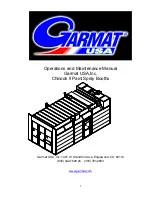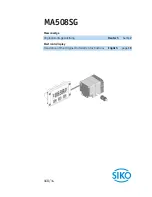
6.
The Model B Manual Emergency Station (see Fig. 3) is
also included in the Reliable Type D Double Interlock
Preaction System trim set. It consists of an aluminum
nameplate mechanically attached to a ball valve. The
valve handle in its OFF position is guarded against acci-
dental turning to the ON position (and system discharge)
by a nylon cable tie provided with each trim kit. The cable
tie is inserted, as shown in Fig. 3, after the system has
been restored for operation. The nylon cable tie is de-
signed to allow, in case of an emergency, forceful turning
of the valve handle to the ON position. As an alternative to
the Model B Hydraulic Manual Emergency Station, the
Model A Hydraulic Manual Emergency Pull Box (see Reli-
able Bulletin 506) is also available and can be provided as
an option.
Whenever ambient temperature conditions are high,
the water temperature in the Model DDX Deluge Valve’s
pushrod chamber could possibly increase, thereby in-
creasing the pressure in the chamber to values exceed-
ing the rated pressure of the system. In an indoor
installation where standard room temperatures are ex-
ceeded, a pressure relief kit may be needed. Pressure re-
lief kit, P/N 6503050001, can be installed into the pushrod
chamber’s releasing line to limit the pressure to 175 psi
(12,1 bar).
Pressurizing Line Connection
The water supply for the push-rod chamber must be
provided by connection of its inlet pressurizing line to the
water supply piping. Pressurizing lines for multiple Model
DDX Deluge Valve push-rod chambers must never be
manifolded together, having only a single tap on the water
supply piping. Each Model DDX Deluge Valve must have
its own push-rod chamber pressurizing line connection.
This connection must be made on the supply side of the
main water supply control valve. This can be accom-
plished by:
• Using a tapped connection directly below or next to
the main water supply control valve using a welded
outlet or the appropriate mechanical fittings. A
grooved-end outlet coupling is one way to achieve
this (see Fig. 2); or
• Using a water supply control valve that has an avail-
able threaded (NPT) supply-side tap design to allow
for a direct water supply connection to the Model DDX
Deluge Valve’s push-rod chamber.
Caution:
Reliable’s DDX valve is designed with an inlet
restriction built into the pushrod chamber. It is important
not to introduce additional restrictions into the direct wa-
ter supply connection or the discharge from the pushrod
chamber by installing additional valves or improperly in-
stalling the copper lines used in the trim of the valve.
Hydrostatic Testing of DDX Valves and DDX
Systems
As required by NFPA 13, fire sprinkler systems with
working pressures up to and including 150 psi are to be
hydrostatically tested at a water pressure of 200 psi and
maintain that pressure without loss for two hours. Fire
sprinkler systems with working pressures above 150 psi
are required to be hydrostatically tested at 50 psi above
the system working pressure and maintain that pressure
without loss for two hours. In addition to the hydrostatic
tests described above, dry pipe and double interlock
preaction systems require an additional low pressure air
test. In some cases, hydrostatic testing (in accordance
with the NFPA 13 requirements noted above) will result in
pressures that exceed the working pressure of the valve
and trim kit for the two-hour test period.
The valve and applicable trim kit have been tested, ap-
proved and listed under these conditions and as such, hy-
drostatic testing in accordance with NFPA 13 is
acceptable. In addition, the clapper can remain in the
closed position and the trim kit need not be isolated, as
each has been designed to withstand hydrostatic testing
as required by NFPA 13.
Hydrostatically testing the valve and trim to pressures
higher than their rating is limited to the hydrostatic test as
referenced by NFPA 13. It does not address the occur-
rence(s) of a “water hammer” effect, which can indeed
damage the valve. A “water hammer” in the water supply
piping of the valve can create pressures in excess of the
rated pressure and should be avoided by all necessary
means. This condition may be created from improper fire
pump settings, underground construction work, or an im-
proper venting of trapped air in the water supply piping.
System Design Considerations
The automatic sprinklers, air compressor, releasing
devices, electric releasing control equipment, fire detec-
tion devices, manual pull stations, and signaling devices
which are utilized with the Type D Double Interlock
Preaction System must be UL or ULC Listed or FM Ap-
proved, as applicable.
Factory Mutual requires that detection devices in re-
frigerated areas be of the fixed temperature type. In addi-
tion, they must have a temperature rating lower than that
of the sprinklers and preferably, as low as possible for the
given ambient conditions.
The Deluge Valve, and all interconnecting piping must
be located in a readily visible and accessible location and
in an area that can be maintained at a minimum tempera-
ture of 40°F (4°C).
Note:
Heat tracing is not permitted.
Pendent sprinklers, other than dry pendents, used on
preaction systems shall be installed on return bends per
NFPA 13.
The solenoid valve is operated and supervised by the
electrical releasing/control panel. Details on the electrical
portion of this system can be found in Reliable Bulletin
700, “Special Hazards & Special Systems.”
System Air Pressure Requirements
In accordance with NFPA 13, double interlock
preaction systems require a minimum of 7 psi (0,5 bar)
pneumatic pressure to supervise the sprinkler system.
The Model A-2 Pressure Maintenance Device is used to
maintain the system pneumatic pressure between 7 and
10 psi (0,5 and 0,7 bar) where a dry nitrogen gas supply or
a clean, dependable, and continuous (24 hours per day, 7
days per week) compressed air source is available.
To adjust the system pneumatic pressure between 7
and 10 psi (0,5 and 0,7 bar) refer to Reliable Bulletin 251.
The low air pressure alarm switch (Item #5, Fig. 2) is fac-
tory set to operate between 5 and 6 psi (0,3 and 0,4 bar)
with decreasing pressure. If necessary, adjustments can
be made by following the manufacturer’s adjustment pro-
cedure as described in the installation and maintenance
instructions enclosed with the switch.






































